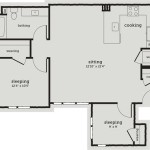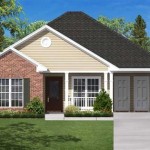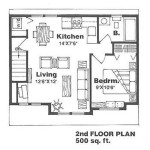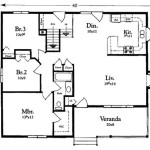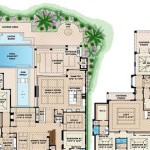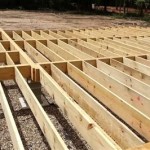Farmhouse Designs and Floor Plans: A Comprehensive Overview
Farmhouse design, both in its exterior aesthetics and interior floor plans, represents a significant trend in contemporary residential architecture. Its popularity stems from a perceived connection to simpler times, a focus on functionality, and an embrace of natural materials. Understanding the core elements of farmhouse design, along with the floor plan considerations that best complement the style, is crucial for homeowners and designers seeking to create an authentic and comfortable living space.
This article will delve into the defining characteristics of farmhouse designs and explore various floor plan options that align with the farmhouse aesthetic. It will discuss architectural features, material selections, and spatial arrangements crucial for achieving a cohesive and functional farmhouse-style home.
Key Exterior Elements of Farmhouse Design
The exterior of a farmhouse is often characterized by specific architectural details that contribute to its distinct appearance. These elements are not merely decorative; they often reflect the practical needs of a working farm, adapted for modern living.
Gabled roofs, typically steep-pitched, are a common feature. These roofs provide ample attic space for storage and contribute to the house's vertical presence. Porches, often expansive and wrapping around multiple sides of the house, are another defining element. These porches serve as transitional spaces, connecting the interior to the outdoors and providing shaded areas for relaxation. Board-and-batten siding, while not exclusive to farmhouse designs, is a prevalent choice. Its vertical lines add visual interest and evoke a sense of rustic charm. Windows are generally large and numerous, designed to maximize natural light. Grids or divided lites are frequently used to add architectural detail and character. Exterior color palettes often lean towards neutral tones, such as whites, grays, and creams, allowing the natural materials and architectural details to stand out. Accents of color may be incorporated through doors, shutters, or landscaping.
The landscaping surrounding a farmhouse often complements the overall aesthetic, featuring elements like gravel driveways, mature trees, and gardens. These features contribute to the sense of connection to nature and create a welcoming atmosphere.
Common Farmhouse Floor Plan Considerations
The floor plan of a farmhouse is as important as its exterior in defining the overall style and functionality of the home. Certain spatial arrangements and design principles are frequently employed to create a layout that is both practical and visually appealing.
Open-concept living spaces are a hallmark of modern farmhouse design. The kitchen, dining area, and living room often flow seamlessly together, creating a large, shared space for family gatherings and entertaining. This open layout promotes a sense of connection and encourages interaction. Large kitchens are another key element. Farmhouse kitchens are typically designed to be the heart of the home, with ample counter space for food preparation, large islands for gathering, and plenty of storage. Apron-front sinks, also known as farmhouse sinks, are a popular choice, adding to the rustic charm of the kitchen. Mudrooms are practical additions, providing a designated space for removing shoes, coats, and outdoor gear. These spaces help to keep the rest of the house clean and organized. Pantries, often walk-in, offer ample storage for food and kitchen supplies. This is especially important in farmhouse kitchens, where large-scale cooking and food preservation may be common.
Bedrooms are often located on the upper floors of the house, providing privacy and separation from the main living areas. Master suites typically include a private bathroom and walk-in closet. Bathrooms are often designed with a focus on comfort and relaxation, featuring elements like freestanding tubs, walk-in showers, and natural materials.
Connectivity to the outdoors is also important, with floor plans often incorporating features like French doors, sliding glass doors, and large windows to maximize natural light and provide easy access to decks, patios, and gardens.
Material Selection and Interior Detailing in Farmhouse Design
The selection of materials and interior details plays a crucial role in creating an authentic farmhouse aesthetic within the home. These elements contribute to the overall sense of warmth, character, and rustic charm.
Natural materials are frequently used throughout the house. Wood, particularly reclaimed wood, is a prominent choice for flooring, beams, and furniture. Stone, such as brick or flagstone, may be used for fireplaces, flooring, or accent walls. Shiplap, a type of wooden planking, is often used for wall cladding, adding texture and visual interest. Metal accents, such as wrought iron hardware or galvanized steel fixtures, can add an industrial touch and complement the rustic aesthetic. Exposed beams, whether structural or decorative, are a common feature, adding architectural detail and visual warmth. Wide plank hardwood floors are a popular choice, evoking a sense of history and authenticity. Neutral color palettes are typically used for walls and ceilings, allowing the natural materials and architectural details to stand out. Accents of color may be incorporated through furnishings, textiles, and artwork. Antique or vintage furniture pieces are often incorporated into the design, adding character and a sense of history. These pieces can be mixed with more contemporary furnishings to create a balanced and eclectic look.
In bathrooms, elements like clawfoot tubs, pedestal sinks, and subway tile can contribute to the farmhouse aesthetic. In kitchens, open shelving is a popular choice, allowing homeowners to display their dishes and cookware. Farmhouse-style lighting fixtures, such as pendant lights or sconces, can add to the overall ambiance of the home.
Ultimately, the selection of materials and interior details should be carefully considered to ensure that they complement the overall design and contribute to the desired aesthetic. The goal is to create a space that is both beautiful and functional, reflecting the values of simplicity, authenticity, and connection to nature.
In summary, farmhouse design encompasses a range of architectural and interior design elements that, when carefully considered and implemented, can create a comfortable, functional, and aesthetically pleasing living space. Understanding the key exterior features, floor plan considerations, and material selections is essential for achieving an authentic and cohesive farmhouse-style home.

Popular Farmhouse Floor Plan Design Cad Pro

Floor Plan Friday Farmhouse Design With Living On The Rear

Country House Designs Floor Plans Farmhouse Home

Small Farmhouse Plans Fit For Fall Blog Eplans Com

Misty Falls House Plan Ranch Plans Farmhouse Two Story

Farm House Shuonya Nava Designs Archdaily

Farmhouse Style House Plan 4 Beds 3 5 Baths 2763 Sq Ft 430 205 Plans

Farm House Plans For Today

One Story Modern Farmhouse Floor Plans

Farmhouse Style House Plan 3 Beds 2 5 Baths 2258 Sq Ft 929 1086 Family Plans

